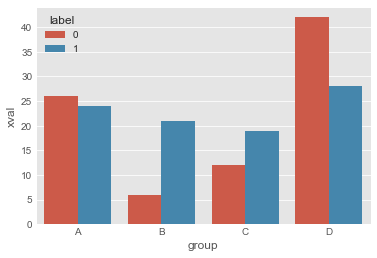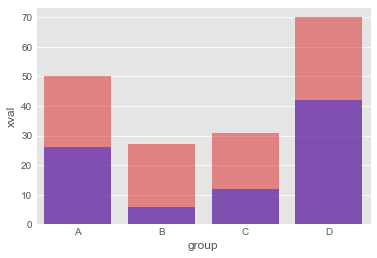막대 그래프(Bar Chart) 그리는 방법-pandas, matplotlib, seaborn, ggplot2
요약 :
시각화할 때 막대 그래프 자주 사용하는데, 검색할 때 마다 방법이 너무 다양하다… 정리해보자.
import numpy as np
import pandas as pd
import seaborn as sns
import matplotlib.pyplot as plt
plt.style.use('ggplot')
import random
np.random.seed(seed=1)
group_list = ['A','B','C','D']
n_size = 20
group = [random.choice(group_list) for i in range(n_size)]
xval = np.random.poisson(lam=10,size=n_size)
label = np.random.binomial(n=1, p=0.5, size=n_size)
label = list(map(str, label))
df = pd.DataFrame({'xval':xval, 'group':group, 'label':label})
df.head()
| xval | group | label | |
|---|---|---|---|
| 0 | 9 | A | 0 |
| 1 | 6 | B | 0 |
| 2 | 7 | A | 1 |
| 3 | 9 | A | 0 |
| 4 | 9 | D | 0 |
df_by_group = df.groupby(['group'])['xval'].sum()
df_by_group_label = df.groupby(['group','label'])['xval'].sum()
df_by_group
group
A 50
B 27
C 31
D 70
Name: xval, dtype: int32
df_by_group_label
| group | label | xval | |
|---|---|---|---|
| 0 | A | 0 | 26 |
| 1 | A | 1 | 24 |
| 2 | B | 0 | 6 |
| 3 | B | 1 | 21 |
| 4 | C | 0 | 12 |
| 5 | C | 1 | 19 |
| 6 | D | 0 | 42 |
| 7 | D | 1 | 28 |
1. pandas
DataFrame.plot.bar(self, x=None, y=None, **kwargs)
x: xlabel or position, optional
y: ylabel or position, optional
한 개의 그룹이 있을 경우
df_by_group = df_by_group.reset_index()
df_by_group.plot.bar(x='group',y='xval',rot=0)
<matplotlib.axes._subplots.AxesSubplot at 0x174fef8dd30>

df_by_group.plot.barh(x='group',y='xval',rot=0)
<matplotlib.axes._subplots.AxesSubplot at 0x174ff441f98>

두 개의 그룹이 있을 경우
- 그룹화된 요약 테이블을 피봇테이블로 만든다
df_by_group_label = df_by_group_label.reset_index()
df_pivot = df_by_group_label.pivot(index='group',columns='label',values='xval')
df_pivot
| label | 0 | 1 |
|---|---|---|
| group | ||
| A | 26 | 24 |
| B | 6 | 21 |
| C | 12 | 19 |
| D | 42 | 28 |
df_pivot.plot.bar(rot=0)
<matplotlib.axes._subplots.AxesSubplot at 0x174ff49ab38>

df_pivot.plot.bar(stacked=True, rot=0)
<matplotlib.axes._subplots.AxesSubplot at 0x174fefb0400>

2. matplotlib
matplotlib.pyplot.bar(x, height, width=0.8, bottom=None, *, align=’center’, data=None, **kwargs)
x : sequence of scalars
height : scalar or sequence of scalars
width : scalar or array-like, optional
bottom : scalar or array-like, optional
한 개의 그룹이 있을 경우
df_by_group = df.groupby(['group'])['xval'].sum()
df_by_group
group
A 50
B 27
C 31
D 70
Name: xval, dtype: int32
label = df_by_group.index
index = np.arange(len(label)) # 0,1,2,3
plt.bar(index, df_by_group)
plt.xticks(index, label, fontsize=15) # label 이름 넣기
([<matplotlib.axis.XTick at 0x174ffa65b70>,
<matplotlib.axis.XTick at 0x174ffa7c978>,
<matplotlib.axis.XTick at 0x174ffa7cef0>,
<matplotlib.axis.XTick at 0x174fd36d048>],
<a list of 4 Text xticklabel objects>)

plt.barh(index, df_by_group)
plt.yticks(index, label, fontsize=15)
([<matplotlib.axis.YTick at 0x174fe7f0860>,
<matplotlib.axis.YTick at 0x174fd4a5be0>,
<matplotlib.axis.YTick at 0x174fe7b4390>,
<matplotlib.axis.YTick at 0x174fd5a95c0>],
<a list of 4 Text yticklabel objects>)

두 개의 그룹이 있을 경우
- plt.bar의 ‘bottom’ 또는 ‘width’ 옵션 을 활용하자
- 2번째층 그룹의 라벨에 따라 데이터프레임을 따로 정의해야한다
df_by_group_by0 = df[df['label']=='0'].groupby(['group'])['xval'].sum()
df_by_group_by1 = df[df['label']=='1'].groupby(['group'])['xval'].sum()
label = df.group.unique()
label = sorted(label)
index = np.arange(len(label))
p1 = plt.bar(index,df_by_group_by0, color='red', alpha=0.5)
p2 = plt.bar(index,df_by_group_by1, color='blue', alpha=0.5,
bottom=df_by_group_by0)
plt.xticks(index,label)
plt.legend((p1[0], p2[0]), ('0', '1'), fontsize=15)
<matplotlib.legend.Legend at 0x174fd5a38d0>

p1 = plt.bar(index,df_by_group_by0, color='red', alpha=0.5,
width=0.4)
p2 = plt.bar(index+0.4,df_by_group_by1, color='blue', alpha=0.5,
width=0.4)
plt.xticks(index,label)
plt.legend((p1[0], p2[0]), ('0', '1'), fontsize=15)
<matplotlib.legend.Legend at 0x174ff711f60>

- 문자열 리스트 정렬하기 참조
import locale
import functools
mylist = ["사과", "바나나", "딸기", "포도"]
locale.setlocale(locale.LC_ALL, '') #한국 기준으로 set
sortedByLocale = sorted(mylist, key=functools.cmp_to_key(locale.strcoll))
sortedByLocale
['딸기', '바나나', '사과', '포도']
3. seaborn
seaborn.barplot(x=None, y=None, hue=None, data=None, order=None, hue_order=None, estimator=<function mean at 0x10a2a03b0>, ci=95, n_boot=1000, units=None, seed=None, orient=None, color=None, palette=None, saturation=0.75, errcolor=’.26’, errwidth=None, capsize=None, dodge=True, ax=None, **kwargs)
x, y, hue: x, y, huenames of variables in data or vector data, optional
data: dataDataFrame, array, or list of arrays, optional
dodge: dodgebool, optional (When hue nesting is used, whether elements should be shifted along the categorical axis.)
한 개의 그룹이 있을 경우
df_by_group = df.groupby(['group'])['xval'].sum().reset_index()
sns.barplot(x='group', y='xval', data=df_by_group)
<matplotlib.axes._subplots.AxesSubplot at 0x174fe8b09e8>

두 개의 그룹이 있을 경우
df_by_group_label = df.groupby(['group','label'])['xval'].sum().reset_index()
sns.barplot(x='group', y='xval', hue='label',data=df_by_group_label )
<matplotlib.axes._subplots.AxesSubplot at 0x174fe7cb048>

df_by_group_by0 = df[df['label']=='0'].groupby(['group'])['xval'].sum().reset_index()
df_by_group_by1 = df[df['label']=='1'].groupby(['group'])['xval'].sum().reset_index()
sns.barplot(x='group', y='xval', data=df_by_group,color="red",alpha=0.5)
sns.barplot(x='group', y='xval', data=df_by_group_by0 ,color="blue",alpha=0.5)
<matplotlib.axes._subplots.AxesSubplot at 0x174ffd2fc88>

4. 파이썬에서 R의 ‘ggplot2’ 사용하기
%matplotlib inline
import plotnine as p9
p9.ggplot(data=df,mapping=p9.aes(x='group',y='xval'))+p9.geom_bar(stat='identity')

<ggplot: (-9223371936731132493)>
p9.ggplot(data=df,mapping=p9.aes(x='group',y='xval',fill='label'))+p9.geom_bar(stat='identity')

<ggplot: (100125509489)>
p9.ggplot(data=df,mapping=p9.aes(x='group',y='xval',fill='label'))+p9.geom_bar(stat='identity')+p9.coord_flip()

<ggplot: (100123695585)>
p9.ggplot(data=df,mapping=p9.aes(x='group',y='xval',fill='label'))+p9.geom_bar(stat='identity',position='dodge')

<ggplot: (100124825846)>